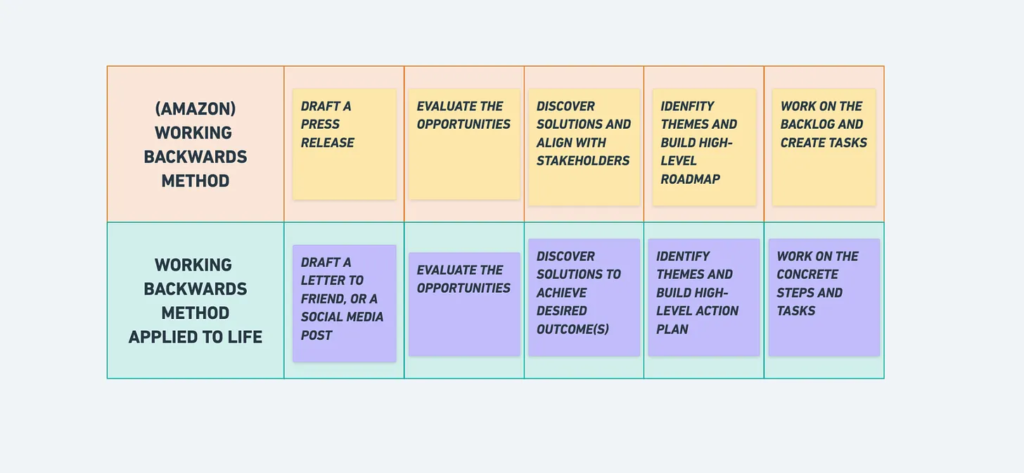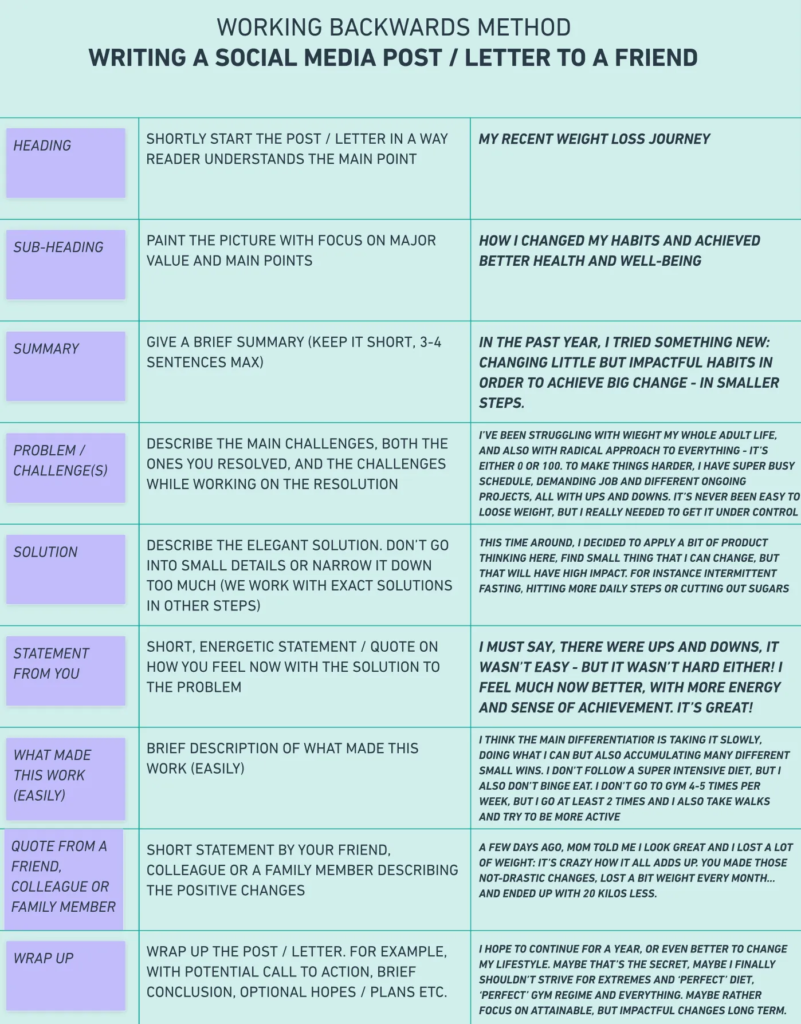There’s a well-known exercise in product management called (Amazon) Working Backwards Method. As the name suggests, it’s widely used at Amazon, and may have also originated there. This exercise can help us work backwords towards our future goals.
Want to learn more product management principles and tips for your personal life?
Get your copy of my book on the topic: Build Your Way
The whole point of the method is starting from the end goal / desired outcome, and working backwards based on where you want to be. As the first step, the team will literally write a press release for a new feature or product, and then evaluate opportunities, develop themes and actual solution(s).
Working Backwards Method Applied to Life
It’s such a great exercise and I wanted to dive into applying this to life and adjust the exercise.
If you’re curious about the original product management exercise, there’s great info in this post.

5 Steps for Working Backwords Exercise Applied to Life
Starting at the end, there are 6 steps in the exercise:
- Draft a letter to a friend, or a social media post
- Evaluate the opportunities
- Discover solutions to achieve the desired outcome(s)
- Identify themes and build a high-level action plan
- Work on the concrete steps and tasks
Step 1: Draft a letter to a friend, or a social media post
First, you need to write a letter to a friend, or a social media post covering the details and describing your end goal / desired outcome as if it was already achieved. This is the most important step as it will define the whole exercise, and it puts you in the mindset of working backwards from the desired outcome.
What Goes Into Your Social Media Post / Letter to a Friend?
The text should cover different details such as a heading, sub-heading, summary, problem description, and solution description. You should also come up with a quote from a friend, colleague or family member, and add your positive statement as well.
The illustration below breaks this down in detail, with a personal example for weight loss. You can also view or download a PDF file available here.

Step 2: Evaluate the opportunities
Based on the items outlined in the previous step, now you need to evaluate the opportunities to actually achieve the desired outcome. This is something you may have hinted at in the solution portion, but now you need to sit down and think it through in a more concrete way.
Further expanding on the example of weight loss, we’d look at opportunity space around my habits and behaviours. Different segments would be different opportunities: eating habits, exercise and physical activity, sleeping patterns, sedentary lifestyle and so on.
Step 3: Discover solutions to achieve the desired outcome(s)
For different opportunities, now we’re digging further – what are concrete solutions I could try?
For our example, cutting out sugar and eating less bread. Making walks with my dog longer. Trying to hit more steps daily. Standing up and having a quick break from computer during work.
Step 4: Identify themes and build a high-level action plan
Now that different opportunities and solutions are laid out, we need to give them structure and shape. We should identify different themes so the work or items are grouped accordingly. Additionally, a high-level action plan should be made for how you plan to execute this.
In this case, and usually, opportunity segments can be good themes (eating, sleeping, activity…) and a rough action plan is what the name says: plan to how you will work on the goals. For the eating theme – first week, cut out all sugars, second week add more salad to every lunch and dinner; and so on for all your themes.
As a rule of thumb, it shouldn’t be very granular, but you should see what works best for you. In this case, month periods would be too long, and weeks seemed proper.
Step 5: Work on the concrete steps and tasks
The final part is working on smaller, concrete steps and tasks to achieve items from your action plan. This can fit into how you organize your day-to-day life, e.g. to-do lists or kanban boards. Or if you don’t have a system, you could build the system around this activity.
In this example, I would work on steps for each week on Mondays or Sundays, and integrate the planning with my existing systems such as personal kanban, notes or shopping lists. (A task could literally be getting healthy groceries, booking time at the gym, cooking etc.)
Wrapping up…

If you try it out, I hope you find this adjusted working backwards method useful.
It’s an experiment, and as with everything, see what works best for you.
Some plans and outcomes may require going through all the steps in much detail and planning, and sometimes, maybe just writing the statement and mentally going through the steps will be enough.
The most important step for me is the writing part, and even if you did just that – it can be both useful, inspiring and potentially transformational.
Enjoyed this post? Want to learn more product management principles and tips for your personal life?
Get your copy of my book on the topic: Build Your Way
